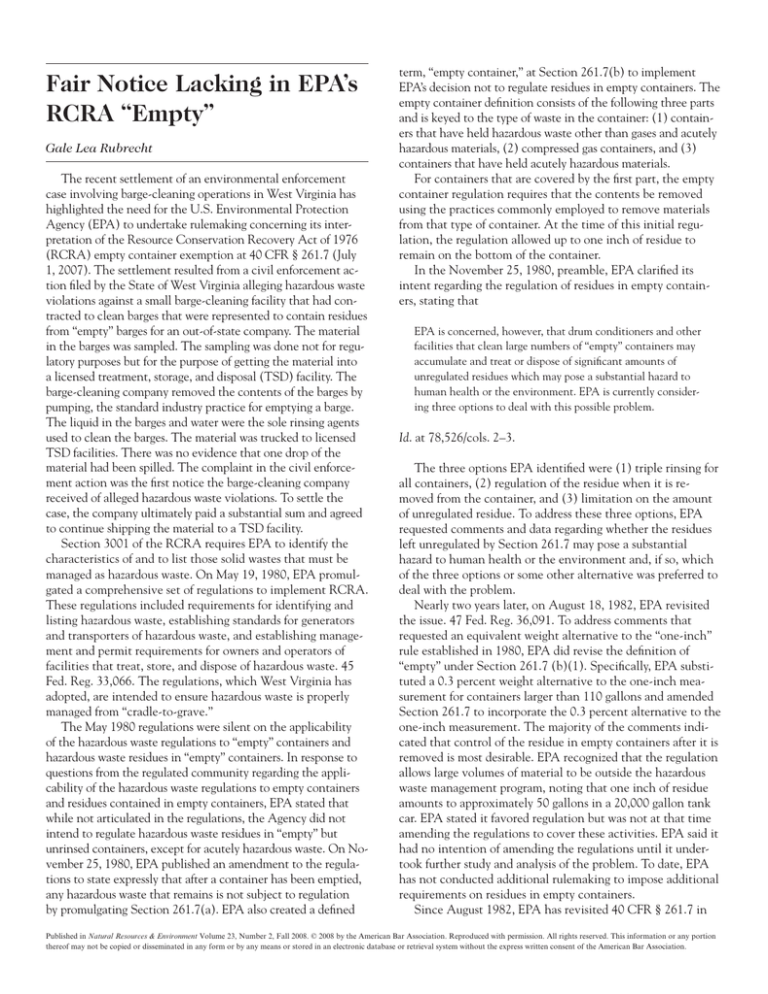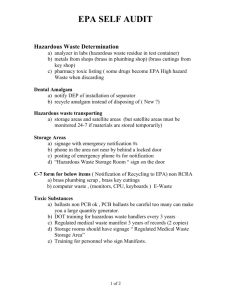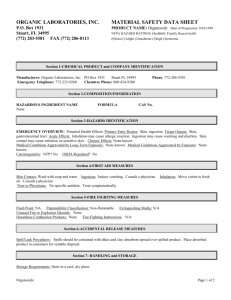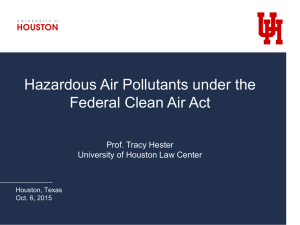Fair Notice Lacking in EPA’s
advertisement

Fair Notice Lacking in EPA’s RCRA “Empty” Gale Lea Rubrecht The recent settlement of an environmental enforcement case involving barge-cleaning operations in West Virginia has highlighted the need for the U.S. Environmental Protection Agency (EPA) to undertake rulemaking concerning its interpretation of the Resource Conservation Recovery Act of 1976 (RCRA) empty container exemption at 40 CFR § 261.7 (July 1, 2007). The settlement resulted from a civil enforcement action filed by the State of West Virginia alleging hazardous waste violations against a small barge-cleaning facility that had contracted to clean barges that were represented to contain residues from “empty” barges for an out-of-state company. The material in the barges was sampled. The sampling was done not for regulatory purposes but for the purpose of getting the material into a licensed treatment, storage, and disposal (TSD) facility. The barge-cleaning company removed the contents of the barges by pumping, the standard industry practice for emptying a barge. The liquid in the barges and water were the sole rinsing agents used to clean the barges. The material was trucked to licensed TSD facilities. There was no evidence that one drop of the material had been spilled. The complaint in the civil enforcement action was the first notice the barge-cleaning company received of alleged hazardous waste violations. To settle the case, the company ultimately paid a substantial sum and agreed to continue shipping the material to a TSD facility. Section 3001 of the RCRA requires EPA to identify the characteristics of and to list those solid wastes that must be managed as hazardous waste. On May 19, 1980, EPA promulgated a comprehensive set of regulations to implement RCRA. These regulations included requirements for identifying and listing hazardous waste, establishing standards for generators and transporters of hazardous waste, and establishing management and permit requirements for owners and operators of facilities that treat, store, and dispose of hazardous waste. 45 Fed. Reg. 33,066. The regulations, which West Virginia has adopted, are intended to ensure hazardous waste is properly managed from “cradle-to-grave.” The May 1980 regulations were silent on the applicability of the hazardous waste regulations to “empty” containers and hazardous waste residues in “empty” containers. In response to questions from the regulated community regarding the applicability of the hazardous waste regulations to empty containers and residues contained in empty containers, EPA stated that while not articulated in the regulations, the Agency did not intend to regulate hazardous waste residues in “empty” but unrinsed containers, except for acutely hazardous waste. On November 25, 1980, EPA published an amendment to the regulations to state expressly that after a container has been emptied, any hazardous waste that remains is not subject to regulation by promulgating Section 261.7(a). EPA also created a defined term, “empty container,” at Section 261.7(b) to implement EPA’s decision not to regulate residues in empty containers. The empty container definition consists of the following three parts and is keyed to the type of waste in the container: (1) containers that have held hazardous waste other than gases and acutely hazardous materials, (2) compressed gas containers, and (3) containers that have held acutely hazardous materials. For containers that are covered by the first part, the empty container regulation requires that the contents be removed using the practices commonly employed to remove materials from that type of container. At the time of this initial regulation, the regulation allowed up to one inch of residue to remain on the bottom of the container. In the November 25, 1980, preamble, EPA clarified its intent regarding the regulation of residues in empty containers, stating that EPA is concerned, however, that drum conditioners and other facilities that clean large numbers of “empty” containers may accumulate and treat or dispose of significant amounts of unregulated residues which may pose a substantial hazard to human health or the environment. EPA is currently considering three options to deal with this possible problem. Id. at 78,526/cols. 2–3. The three options EPA identified were (1) triple rinsing for all containers, (2) regulation of the residue when it is removed from the container, and (3) limitation on the amount of unregulated residue. To address these three options, EPA requested comments and data regarding whether the residues left unregulated by Section 261.7 may pose a substantial hazard to human health or the environment and, if so, which of the three options or some other alternative was preferred to deal with the problem. Nearly two years later, on August 18, 1982, EPA revisited the issue. 47 Fed. Reg. 36,091. To address comments that requested an equivalent weight alternative to the “one-inch” rule established in 1980, EPA did revise the definition of “empty” under Section 261.7 (b)(1). Specifically, EPA substituted a 0.3 percent weight alternative to the one-inch measurement for containers larger than 110 gallons and amended Section 261.7 to incorporate the 0.3 percent alternative to the one-inch measurement. The majority of the comments indicated that control of the residue in empty containers after it is removed is most desirable. EPA recognized that the regulation allows large volumes of material to be outside the hazardous waste management program, noting that one inch of residue amounts to approximately 50 gallons in a 20,000 gallon tank car. EPA stated it favored regulation but was not at that time amending the regulations to cover these activities. EPA said it had no intention of amending the regulations until it undertook further study and analysis of the problem. To date, EPA has not conducted additional rulemaking to impose additional requirements on residues in empty containers. Since August 1982, EPA has revisited 40 CFR § 261.7 in Published in Natural Resources & Environment Volume 23, Number 2, Fall 2008. © 2008 by the American Bar Association. Reproduced with permission. All rights reserved. This information or any portion thereof may not be copied or disseminated in any form or by any means or stored in an electronic database or retrieval system without the express written consent of the American Bar Association. the Federal Register on five occasions. In none of these Federal Registers does EPA regulate the empty container materials. First, EPA made a nonsubstantive change in regulatory reference due to renumbering of RCRA regulations (48 Fed. Reg. 14,294, Apr. 1, 1983). Second, EPA added dioxin to the list of substances requiring triple rinsing (50 Fed. Reg. 1999, Jan. 14, 1985). Third, EPA added 40 CFR Part 268, the “land ban” regulations, to the list of regulations from which empty containers and residues are exempt (51 Fed. Reg. 40,637, Nov. 7, 1986). Fourth, EPA amended Section 261.7(b)(1) by substituting 119 gallons for 110 gallons as the threshold for containers to comport with the U.S. Department of Transportation’s 1991 revised definition of “bulk container” as 119 gallons or greater (70 Fed. Reg. 10,815, Mar. 4, 2005). Fifth, EPA added 40 CFR Part 267, standards for hazardous waste management facilities operating under a standardized permit, to the list of regulations from which empty containers and residues are exempt (70 Fed. Reg. 53,453, Sept. 8, 2005). In addition to these Federal Registers, EPA responded to a comment and clarified how the existing “empty container” regulation operates in an unrelated final rule published on October 4, 2005. 70 Fed. Reg. 57,769. The preamble discussion of Section 261.7 arose in the context of EPA’s response to a comment concerning rinsates from empty containers. Although outside the scope of the proposed rulemaking, EPA took the opportunity to respond. EPA explained that a container can contain a small amount of nonacute hazardous waste and still be considered “empty” for the purpose of hazardous waste regulation and that the waste remaining in this “empty” container is not subject to hazardous waste regulation. EPA stated that when the residue is removed from an “empty” container, the residue is subject to regulation as hazardous waste if the removal or subsequent management of the residue generates a new hazardous waste that exhibits any of the characteristics of hazardous waste. EPA further explained that Section 261.7 does not directly exempt rinse water from regulation as a hazardous waste. EPA said that if the rinsing agent includes a solvent (or other chemical) that would be a listed hazardous waste when discarded, the rinsate from an “empty” container would be considered a listed hazardous waste. To date, EPA has not made any further relevant revisions to the requirements of 40 CFR § 261.7. This conclusion is confirmed by EPA as recently as September 2005 in a container training manual. In the September 2005 container training manual, EPA states that it is still reviewing whether residues or rinsate from an empty container that exhibits a characteristic of hazardous waste is exempt or regulated. The conclusion that residues in or removed from an empty container are not regulated as hazardous waste is also consistent with EPA guidance. The EPA Office of Solid Waste and Emergency Response (OSWER) directives explicitly state that even the burning, direct land disposal, or spillage of residuals from drum cleaning is not regulated as hazardous waste, notwithstanding the fact that the residuals would exhibit a characteristic of hazardous waste. A RCRA inspection manual also confirms that if the residues in an “empty” container are subsequently exhumed and managed, the resulting material is not subject to hazardous waste regulation, including the requirement to determine if the solid waste exhibits a hazardous characteristic. The manual notes that wastes under Section 261.7 are not included in determining quantities for generator status as conditionally exempt small quantity generator, small quantity generator, or large quantity generator. In addition to the October 4, 2005 Federal Register, EPA has responded to inquiries on rinsates from “empty” containers in OSWER directives. A 1983 OSWER directive states that the use of water and rinsing agents to clean empty containers is not hazardous waste treatment. An April 1990 OSWER directive provides that rinsates from an “empty” container are totally outside the regulatory program, including the requirement that a generator make a hazardous waste determination. However, an EPA letter issued to a private law firm on April 12, 2004, rescinds that portion of the April 1990 OSWER directive and states that the empty container rinsate would not be a hazardous waste unless the rinsing agent met one of the hazardous waste characteristics or would be listed when discarded. West Virginia focused on this letter as well as the preamble in the unrelated October 4, 2005, rulemaking in support of its allegations of RCRA violations by the barge-cleaning company. Under EPA’s rulemakings two conditions must be met to satisfy the requirements of a RCRA “empty” container: (1) all wastes have been removed that can be removed using the practices commonly employed to remove materials from that type of container and (2) for a barge, the quantity remaining must not exceed either 1 inch or 0.3 percent by weight of the total capacity of the barge. EPA’s regulations and other public statements fail to notify a regulated party that residues in a barge that is “empty” are subject to regulation under RCRA. Likewise, EPA’s regulations do not provide notice that residues that are removed from an “empty” barge and managed in another barge are subject to regulation where removal and management do not generate a new hazardous waste. Similarly, EPA’s regulations do not give notice that rinsate from cleaning an “empty” barge is subject to regulation where the rinsing agent used is water or not characteristic of hazardous waste or a listed hazardous waste when discarded. EPA should complete the study and analysis it promised nearly three decades ago and undertake rulemaking to address regulation of residues and rinsates from “empty” containers. In addition to the potential harm to public health and environment, EPA’s failure to do so may undermine its own enforcement actions as well as undermine its credibility with regulated parties. Ms. Rubrecht is a member of Jackson Kelly PLLC, in Charleston, West Virginia, and a member of the editorial board of Natural Resources & Environment. She may be reached at galelea@ jacksonkelly.com. Ms. Rubrecht represented the West Virginia barge-cleaning facility in the civil enforcement action. Published in Natural Resources & Environment Volume 23, Number 2, Fall 2008. © 2008 by the American Bar Association. Reproduced with permission. All rights reserved. This information or any portion thereof may not be copied or disseminated in any form or by any means or stored in an electronic database or retrieval system without the express written consent of the American Bar Association.







